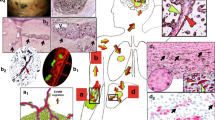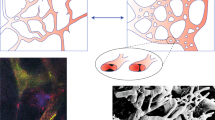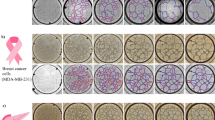Key Points
-
Tumours cannot grow without a blood supply. They promote the growth of new vessels through angiogenesis; initiation of angiogenesis (the 'angiogenic switch') is an important and early event in tumour progression.
-
Tumour blood vessels are morphologically different from normal blood vessels; they are tortuous, leaky and surrounded by too few (or abnormal) pericytes.
-
Tumour blood vessels carry distinct molecular markers in the endothelium, pericytes and in the extracellular matrix. Many of these markers are shared by angiogenic vessels in non-malignant conditions.
-
Tumour lymphatics are an important conduit of metastasis. The use of new lymphatic vessel markers has revealed the presence of lymphatic vessels within some, but not all, tumours.
-
Tumour cells themselves might form vessel-like channels within the tumour. These channels are lined by an extracellular matrix, rather than cells; their role as part of the tumour's circulatory system is unclear.
-
The specialization of tumour vessels makes it possible to target diagnostic and therapeutic agents into tumours and provides new targets for drug discovery.
Abstract
Tumour blood vessels express markers that are not present in resting blood vessels of normal tissues, but that can be shared by angiogenic vessels in non-malignant conditions. Many of these proteins are functionally important in the angiogenic process. Some tumours also contain lymphatic vessels, as well as channels that consist of cancer cells and their extracellular matrix. These special features of tumour vessels are good targets for cancer therapies.
This is a preview of subscription content, access via your institution
Access options
Subscribe to this journal
Receive 12 print issues and online access
$209.00 per year
only $17.42 per issue
Buy this article
- Purchase on Springer Link
- Instant access to full article PDF
Prices may be subject to local taxes which are calculated during checkout



Similar content being viewed by others
References
Ruoslahti, E. Targeting tumor vasculature with homing peptides from phage display. Semin Cancer Biol 10, 435–442 (2000).
Veikkola, T., Karkkainen, M., Claesson-Welsh, L. & Alitalo, K. Regulation of angiogenesis via vascular endothelial growth factor receptors. Cancer Res. 60, 203–212 (2000).
Jackson, D. G., Prevo, R., Clasper, S. & Banerji, S. LYVE-1, the lymphatic system and tumor lymphangiogenesis. Trends Immunol. 22, 317–321 (2001).
Folberg, R., Hendrix, M. J. & Maniotis, A. J. Vasculogenic mimicry and tumor angiogenesis. Am. J. Pathol. 156, 361–381 (2000).
Maniotis, A. J. et al. Vascular channel formation by human melanoma cells in vivo and in vitro: vasculogenic mimicry. Am. J. Pathol. 155, 739–752 (1999).The authors propose that the PAS-positive structures found in highly aggressive melanomas are manifestations of the ability of the tumour cells to form vascular channels in vivo . They refer to this phenomenon as 'vasculogenic mimicry' (see also references 4 and 6).
McDonald, D. M., Munn, L. & Jain, R. K. Vasculogenic mimicry: how convincing, how novel, and how significant? Am. J. Pathol. 156, 383–388 (2000).A critique of the vasculogenic mimicry concept proposed in reference 5.
Chang, Y. S. et al. Mosaic blood vessels in tumors: frequency of cancer cells in contact with flowing blood. Proc. Natl Acad. Sci. USA 97, 14608–14613 (2000).Shows that a surprisingly high percentage of the inner lining of tumour blood vessels can be covered by tumour cells, rather than endothelial cells.
Hanahan, D. & Folkman, J. Patterns and emerging mechanisms of the angiogenic switch during tumorigenesis. Cell 86, 353–364 (1996).
Hanahan, D. & Weinberg, R. A. The hallmarks of cancer. Cell 100, 57–70 (2000).
Ferrara, N. & Alitalo, K. Clinical applications of angiogenic growth factors and their inhibitors. Nature Med. 5, 1359–1364 (1999).
Holash, J. et al. Vessel cooption, regression, and growth in tumors mediated by angiopoietins and VEGF. Science 284, 1994–1998 (1999).
Jain, R. K. The Eugene M. Landis Award Lecture 1996. Delivery of molecular and cellular medicine to solid tumors. Microcirculation 4, 1–23 (1997).
Hashizume, H. et al. Openings between defective endothelial cells explain tumor vessel leakiness. Am. J. Pathol. 156, 1363–1380 (2000).
Hellstrom, M. et al. Lack of pericytes leads to endothelial hyperplasia and abnormal vascular morphogenesis. J. Cell Biol. 153, 543–553 (2001).
Plate, K. H., Breier, G., Millauer, B., Ullrich, A. & Risau, W. Up-regulation of vascular endothelial growth factor and its cognate receptors in a rat glioma model of tumor angiogenesis. Cancer Res. 53, 5822–5827 (1993).
Valtola, R. et al. VEGFR-3 and its ligand VEGF-C are associated with angiogenesis in breast cancer. Am. J. Pathol. 154, 1381–1390 (1999).
Gerety, S. S., Wang, H. U., Chen, Z. F. & Anderson, D. J. Symmetrical mutant phenotypes of the receptor Eph-4 and its specific transmembrane ligand ephrin-B2 in cardiovascular development. Mol Cell 4, 403–414 (1999).
Pandey, A., Shao, H., Marks, R. M., Polverini, P. J. & Dixit, V. M. Role of B61, the ligand for the Eck receptor tyrosine kinase, in TNF-α-induced angiogenesis. Science 268, 567–569 (1995).
Ogawa, K. et al. The ephrin-A1 ligand and its receptor, EphA2, are expressed during tumor neovascularization. Oncogene 19, 6043–6052 (2000).
Shin, D. et al. Expression of EphrinB2 identifies a stable genetic difference between arterial and venous vascular cells, and marks subsets of adult neovascularization. Dev. Biol. 230, 139–150 (2001).
Gale, N. W. et al. Ephrin-B2 selectively marks arterial vessels and neovascularization sites in the adult, with expression in both endothelial and smooth muscle cells. Dev. Biol. 230, 151–160 (2001).
Balza, E. et al. Lack of specificity of endoglin expression for tumor blood vessels. Int. J. Cancer 94, 579–585 (2001).
Giancotti, F. G. & Ruoslahti, E. Integrin signaling. Science 285, 1028–1033 (1999).
Brooks, P. C., Clark, R. A. & Cheresh, D. A. Requirement of vascular integrin αvβ3 for angiogenesis. Science 264, 569–571 (1994).
Erdreich-Epstein, A. et al. Integrins αvβ3 and αvβ5 are expressed by endothelium of high-risk neuroblastoma and their inhibition is associated with increased endogenous ceramide. Cancer Res. 60, 712–721 (2000).
Conforti, G. et al. Human endothelial cells express integrin receptors on the luminal aspect of their membrane. Blood 80, 437–446 (1992).
Kim, S., Bell, K., Mousa, S. A. & Varner, J. A. Regulation of angiogenesis in vivo by ligation of integrin α5β1 with the central cell-binding domain of fibronectin. Am. J. Pathol. 156, 1345–1362 (2000).
Senger, D. R. et al., Angiogenesis promoted by vascular endothelial growth factor: regulation through α1β1 and α2β1 integrins. Proc. Natl Acad. Sci. USA 94, 13612–13617 (1997).
Brooks, P. C. et al. Antiintegrin αvβ3 blocks human breast cancer growth and angiogenesis in human skin. J. Clin. Invest. 96, 1815–1822 (1995).
Eliceiri, B. P. & Cheresh, D. A. The role of αv integrins during angiogenesis: insights into potential mechanisms of action and clinical development. J. Clin. Invest. 103, 1227–1230 (1999).
Dallabrida, S. M., De Sousa, M. A. & Farrell, D. H. Expression of antisense to integrin subunit β3 inhibits microvascular endothelial cell capillary tube formation in fibrin. J. Biol. Chem. 275, 32281–32288 (2000).
Yang, J. T., Rayburn, H. & Hynes, R. O. Embryonic mesodermal defects in α5 integrin-deficient mice. Development 119, 1093–1105 (1993).
Reynolds, L. E. et al. Enhanced pathological angiogenesis in mice lacking β3 integin or β3 and β5 integins. Nature Med. 8, 27–34 (2002).
Bader, B. L., Rayburn, H., Crowley, D. & Hynes, R. O. Extensive vasculogenesis, angiogenesis, and organogenesis precede lethality in mice lacking all αv integrins. Cell 95, 507–519 (1998).
Wary, K. K., Mainiero, F., Isakoff, S. J., Marcantonio, E. E. & Giancotti, F. G. The adaptor protein Shc couples a class of integrins to the control of cell cycle progression. Cell 87, 733–743 (1996).
Matter, M. L. & Ruoslahti, E. A signaling pathway from the α5β1 and αvβ3 integrins that elevates BCL-2 transcription. J. Biol. Chem. 276, 27757–27763 (2001).
Stupack, D. G., Puente, X. S., Boutsaboualoy, S., Storgard, C. M. & Cheresh, D. A. Apoptosis of adherent cells by recruitment of caspase-8 to unligated integrins. J. Cell Biol. 155, 459–470 (2001).
Soldi, R. et al. Role of αvβ3 integrin in the activation of vascular endothelial growth factor receptor-2. EMBO J. 18, 882–892 (1999).
Borges, E., Jan, Y. & Ruoslahti, E. Platelet-derived growth factor receptor-β and vascular endothelial growth factor receptor 2 bind to the β3 integrin through its extracellular domain. J. Biol. Chem. 275, 39867–39873 (2000).
Byzova, T. V. et al. A mechanism for modulation of cellular responses to VEGF: activation of the integrins. Mol. Cell 6, 851–860 (2000).
Friedlander, M. et al. Definition of two angiogenic pathways by distinct αv integrins. Science 270, 1500–1502 (1995).
Pozzi, A. et al. Elevated matrix metalloprotease and angiostatin levels in integrin α1 knockout mice cause reduced tumor vascularization. Proc. Natl Acad. Sci. USA 97, 2202–2207 (2000).
Silletti, S., Kessler, T., Goldberg, J., Boger, D. L. & Cheresh, D. A. Disruption of matrix metalloproteinase 2 binding to integrin αvβ3 by an organic molecule inhibits angiogenesis and tumor growth in vivo. Proc. Natl Acad. Sci. USA 98, 119–124 (2001).The latest in the use of the αvβ3 integrin in inhibiting angiogenesis. Exemplifies the central role of this integrin in angiogenesis. But see also reference 33 , which reports that mice lacking this integrin have enhanced tumour-induced angiogenesis.
Deryugina, E. I., Bourdon, M. A., Jungwirth, K., Smith, J. W. & Strongin, A. Y. Functional activation of integrin αvβ3 in tumor cells expressing membrane-type 1 matrix metalloproteinase. Int. J. Cancer 86, 15–23 (2000).
Yi, M. & Ruoslahti, E. A fibronectin fragment inhibits tumor growth, angiogenesis, and metastasis. Proc. Natl Acad. Sci. USA 98, 620–624 (2001).
Arap, W., Pasqualini, R. & Ruoslahti, E. Cancer treatment by targeted drug delivery to tumor vasculature in a mouse model. Science 279, 377–380 (1998).
Brown, C. K., Modzelewski, R. A., Johnson, C. S. & Wong, M. K. A novel approach for the identification of unique tumor vasculature binding peptides using an E. coli peptide display library. Ann. Surg. Oncol. 7, 743–749 (2000).
Kennel, S. J. et al. Labeling and distribution of linear peptides identified using in vivo phage display selection for tumors. Nucl. Med. Biol. 27, 815–825 (2000).
Assa-Munt, N., Jia, X., Laakkonen, P. & Ruoslahti, E. Solution structures and integrin binding activities of an RGD peptide with two isomers. Biochemistry 40, 2373–2378 (2001).
Pasqualini, R. et al. Aminopeptidase N is a receptor for tumor-homing peptides and a target for inhibiting angiogenesis. Cancer Res. 60, 722–727 (2000).
Bhagwat, S. V. et al. CD13/APN is activated by angiogenic signals and is essential for capillary tube formation. Blood 97, 652–659 (2001).
St Croix, B. et al. Genes expressed in human tumor endothelium. Science 289, 1197–1202 (2000).
Carson-Walter, E. B. et al. Cell surface tumor endothelial markers are conserved in mice and humans. Cancer Res. 61, 6649–6655 (2001).
Schlingemann, R. O., Rietveld, F. J., de Waal, R. M., Ferrone, S. & Ruiter, D. J. Expression of the high molecular weight melanoma-associated antigen by pericytes during angiogenesis in tumors and in healing wounds. Am. J. Pathol. 136, 1393–1405 (1990).
Schrappe, M. et al. Correlation of chrondroitin sulfate proteoglycan expression on proliferating brain capillary endothelial cells with the malignant phenotype of astroglial cells. Cancer Res. 51, 4986–4993 (1991).
Ozerdem, U., Grako, K. A., Dahlin-Huppe, K., Monosov, E. & Stallcup, W. B. NG2 proteoglycan is expressed exclusively by mural cells during vascular morphogenesis. Dev. Dyn. 222, 218–227 (2001).
Burg, M. A., Pasqualini, R., Arap, W., Ruoslahti, E. & Stallcup, W. B. NG2 proteoglycan-binding peptides target tumor neovasculature. Cancer Res. 59, 2869–2874 (1999).
Castellani, P. et al. The fibronectin isoform containing the ED-B oncofetal domain; a marker of angiogenesis. Int. J. Cancer 59, 612–618 (1994).
Nilsson, F., Kosmehl, H., Zardi, L. & Neri, D. Targeted delivery of tissue factor to the ED-B domain of fibronectin, a marker of angiogenesis, mediates the infarction of solid tumors in mice. Cancer Res. 61, 711–716 (2001).The latest from a group that established the ED-B splicing variant of fibronectin as a marker of the extracellular matrix in angiogenic vessels.
Contrino, J., Hair, G., Kreutzer, D. L. & Rickles, F. R. In situ detection of tissue factor in vascular endothelial cells: correlation with the malignant phenotype of human breast disease. Nature Med. 2, 209–215 (1996).
Hu, Z. & Garen, A. Targeting tissue factor on tumor vascular endothelial cells and tumor cells for immunotherapy in mouse models of prostatic cancer. Proc. Natl Acad. Sci. USA 98, 12180–12185 (2001).
Leu, A. J., Berk, D. A., Lymboussaki, A., Alitalo, K. & Jain, R. K. Absence of functional lymphatics within murine sarcoma: a molecular and functional evaluation. Cancer Res. 60, 4324–4327 (2000).
Breiteneder-Geleff, S. et al. Angiosarcomas express mixed endothelial phenotypes of blood and lymphatic capillaries: podoplanin as a specific marker for lymphatic endothelium. Am. J. Pathol. 154, 385–394 (1999).
Mouta-Carreira, C. et al. LYVE-1 is not restricted to the lymph vessels: expression in normal liver blood sinusoids and down-regulation in human liver cancer cirrhosis. Cancer Res. 61, 8079–8084 (2001).
Mandriota, S. J. et al. Vascular endothelial growth factor-C-mediated lymphangiogenesis promotes tumour metastasis. EMBO J. 20, 672–682 (2001).In this paper and in references 66 and 68 , the authors use VEGFC and VEGFD to selectively promote the growth of lymphatic vessels in and around tumours in mice. They find a strong correlation between the density of lymphatic vessels and lymphatic metastasis.
Stacker, S. A. et al. VEGF-D promotes the metastatic spread of tumor cells via the lymphatics. Nature Med. 7, 186–191 (2001).
Fukuda, H., Yamada, T., Kamata, S. & Saitoh, H. Anatomic distribution of intraprostatic lymphatics: implications for the lymphatic spread of prostate cancer — a preliminary study. Prostate 44, 322–327 (2000).
Skobe, M. et al. Induction of tumor lymphangiogenesis by VEGF-C promotes breast cancer metastasis. Nature Med. 7, 192–198 (2001).
Pepper, M. S. Lymphangiogenesis and tumor metastasis: myth or reality? Clin. Cancer Res. 7, 462–468 (2001).
Mäkinen, T. et al. Isolated lymphatic endothelial cells transduce growth, survival and migratory signals via the VEGF-C/D receptor VEGFR-3. EMBO J. 20, 4762–4773 (2001).
Hendrix, M. J. et al. Expression and functional significance of VE-cadherin in aggressive human melanoma cells: role in vasculogenic mimicry. Proc. Natl Acad. Sci. USA 98, 8018–8023 (2001).
Hess, A. R. et al. Molecular regulation of tumor cell vasculogenic mimicry by tyrosine phosphorylation: role of epithelial cell kinase (Eck/EphA2). Cancer Res. 61, 3250–3255 (2001).
Seftor, R. E. B. et al. Cooperative interactions of laminin α5β2 chain, matrix metalloproteinase-2, and membrane type-matrix/metallo-proteinase are required for mimicry of embryonic vasculogenesis by aggressive melanoma. Cancer Res. 61, 6322–6327 (2001).
Damsky, C. H. & Fisher, S. J. Trophoblast pseudo-vasculogenesis: faking it with endothelial adhesion receptors. Curr. Opin. Cell Biol. 10, 660–666 (1998).
Kerbel, R. S. Inhibition of tumor angiogenesis as a strategy to circumvent acquired resistance to anti-cancer therapeutic agents. Bioessays 13, 31–36 (1991).
Sipkins, D. A. Detection of tumor angiogenesis in vivo by αvβ3-targeted magnetic resonance imaging. Nature Med. 4, 623–626 (1998).Ligand-occupied VEGF receptor might be a more specific marker of angiogenesis than the receptor itself.
Ellerby, H. M. et al. Anti-cancer activity of targeted pro-apoptotic peptides. Nature Med. 5, 1032–1038 (1999).Tumour-homing peptides were used to direct a peptide that disrupts bacterial membranes into target cells, where the anti-bacterial peptide breaks up mitochondrial membranes, inducing apoptosis.
Chen, Y. et al. RGD-tachyplesin inhibits tumor growth. Cancer Res. 61, 2434–2438 (2001).
Curnis, F. et al. Enhancement of tumor necrosis factor antitumor immunotherapeutic properties by targeted delivery to aminopeptidase N (CD13). Nature Biotechnol. 18, 1185–1190 (2000).
Cooke, S. P. et al. A strategy for antitumor vascular therapy by targeting the vascular endothelial growth factor: receptor complex. Cancer Res. 61, 3653–3659 (2001).
Carmeliet, P. & Jain, R. K. Angiogenesis in cancer and other diseases. Nature 407, 249–257 (2000).
Acknowledgements
I thank members of my laboratory for discussions and E. Engvall and E. Pasquale for comments on the manuscript. The author's work is supported by grants from the National Cancer Institute and the Susan G. Komen Breast Cancer Foundation.
Author information
Authors and Affiliations
Related links
Related links
DATABASES
FURTHER INFORMATION
Dyax Phage Display Technologies
NCI cancer trials — angiogenesis inhibitors
Special project on angiogenesis
Glossary
- PERICYTE
-
A cell that is related to the smooth muscle cell and that forms a layer immediately underneath the endothelial-cell layer in vessels.
- RGD
-
A three amino-acid sequence (arginine–glycine–aspartic-acid) that serves as the recognition site for integrin receptors in the extracellular matrix (ECM). RGDs are present in ECM proteins, such as fibronectin, vitronectin and collagens.
- PHAGE LIBRARY
-
These are created by allowing phage to incorporate random pieces of DNA into its genome. The DNA contains (in theory) all of the possible sequence permutations, but only one of these sequences becomes incorporated into each phage's genome. Each phage then expresses one encoded peptide at its surface. In practice, a seven amino-acid sequence is the longest peptide for which all permutations can be expressed in an individual phage library. Phage libraries can be used to screen for peptides that interact with a certain molecule.
- GLOMERULAR PODOCYTE
-
A cell that forms foot-like processes that support the filtration membrane in the kidney glomerulus.
- UVEA
-
A pigmented area of the eye.
- PERIODIC ACID-SCHIFF (PAS) STAINING
-
A histochemical technique that highlights extracellular matrices.
Rights and permissions
About this article
Cite this article
Ruoslahti, E. Specialization of tumour vasculature. Nat Rev Cancer 2, 83–90 (2002). https://doi.org/10.1038/nrc724
Issue Date:
DOI: https://doi.org/10.1038/nrc724
This article is cited by
-
The JNK-EGR1 signaling axis promotes TNF-α-induced endothelial differentiation of human mesenchymal stem cells via VEGFR2 expression
Cell Death & Differentiation (2023)
-
Cancer nanomedicine: emergence, expansion, and expectations
SN Applied Sciences (2023)
-
Multifunctional nanomedicine strategies to manage brain diseases
Drug Delivery and Translational Research (2023)
-
Prediction of prostate cancer grade using fractal analysis of perfusion MRI: retrospective proof-of-principle study
European Radiology (2022)
-
Preparation of nanoparticles of β-cyclodextrin-loaded scutellarein anti-tumor activity research by targeting integrin αvβ3
Cancer Nanotechnology (2021)



